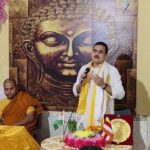AROUSE, MOTHER OF ALL CIVILISATIONS!
- By : Anirban Ganguly
- Category : Articles
It requires great mettle and vision to create anew a cultural dream that earns world recognition. The Chinese have formulated theirs. We must too
The late Huh Shih, nationalist scholar, diplomat and one of the legendary leaders of Chinese thought, in a paper presented at the Harvard Tercentenary Conference of Arts and Science in 1936, made a fundamental observation on India’s contribution to the evolution of Chinese civilisation.
“India”, argued Huh, “conquered and dominated China culturally for two thousand years without ever having to send a single soldier across the border.…Never before had China seen a religion so rich in imagery, so beautiful and captivating in ritualism and so bold in cosmological and metaphysical speculations. Like a poor beggar suddenly halting before a magnificent storehouse of precious stones of dazzling brilliancy and splendour, China was overwhelmed, baffled and overjoyed. She begged and borrowed freely from this munificent giver…China’s indebtedness to India can never be fully told.”
In his seminal work, India and World Civilisations, while referring to India’s civilisational impact on China, DP Singhal noted how China finds mention in numerous Sanskrit texts and of how scholars are agreed upon the fact of third-century Chinese literature being full of geographic and mythological elements derived from India.
Referring to India’s, once pan-continental reach and influence, Japanese scholar Shigeo Kamata observed how the “greatest factor in the spread of Buddhism throughout China was the production of the Chinese translations of Buddhist scriptures by Indian monks who came to China” and of Chinese monks who went to India in search of enlightenment and were allowed to take sack loads of Indian manuscripts back home.
Swami Vivekananda, during his first journey to the West, was fascinated to see a temple in Canton, contain Sanskrit writings. In his treatise on the civilisational encounters between the East and the West, the Swami exultingly wrote how ‘Old Shiva’ on ‘His bull’ with his ‘damaru’ travelled “from India, on the one side, to Sumatra, Borneo, Celebes, Australia, as far as the shores of America.” “Mother Kali”, the Swami continued charting the spread “is still exacting her worship even in China and Japan.”
Sri Aurobindo pointing at the spread of India’s “arts and epics and creeds in the Archipelago” spoke of how her religions conquered China and Japan and spread “westward as far as Palestine and Alexandria.” Similarly, describing India’s contribution towards creating a grand civilisational dream for other cultures and peoples, the celebrated French Indologist Sylvain Lévi, wrote of how India “propagated her beliefs, her tales and her civilisation” from Persia to the Chinese Sea, from the “icy regions of Siberia to the islands of Java and Borneo” leaving her “indelible imprints on one-fourth of the human race in the course of a long succession of centuries.” The legendary Will Durant, summarising India’s civilisational spread and control, acknowledged ‘Mother India’ as the “mother of us all.”
Various grand civilisational dreams that were to grow in course of the aeons had their original inspirational roots in the Indian civilisational vision. India contributed to the evolution of many such dreams. Ingredients that could still help us evolve a new civilisational dream continue to abound in such descriptions of our past.
Thus, it is one thing for our leaders to visit the ‘Forbidden City’ and be feted and be told of our past cultural links but it requires an altogether different mettle and vision to create anew a dream that earns world recognition. While our hosts in Beijing have formulated theirs and seem to doggedly work towards its fruition, the essential question that we need to ask ourselves is: Have we even begun formulating ours or are we acquiescing in the rise of a single dream in the region?

















